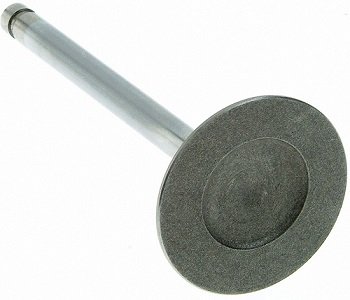
This auto repair article is about engine valves and some of the common problems they can cause when something goes wrong with them.
Learn how overhead systems work and see how to address noise, engine misfires and smoke problems when they go bad.
Also provided is an overview of the symptoms and solutions for when an engine is having a problem with an intake valve as opposed to an exhaust valve. These conditions have a completely different set of symptoms.
How the Valves Work
The main function of an engine valve is to open and close rapidly. This allows the air and fuel charge to enter the combustion chamber and after ignition, the exhaust valve allows the waste gases to flow out into the exhaust system.
 The engine can’t inhale and exhale unless the valve opens and closes at the right time. If you need any further explanation of how this 4 stroke process works I provide more detail about the individual cycles on my page about how engines work.
The engine can’t inhale and exhale unless the valve opens and closes at the right time. If you need any further explanation of how this 4 stroke process works I provide more detail about the individual cycles on my page about how engines work.
Depending on your age you may remember that back in the day it was common for the local auto repair shop to say, “hey you need a valve job”. You don’t hear this as much today.
This is because of the improved manufacturing process and tighter tolerances on modern engines. Regardless, if you put enough miles on even a modern engine you might experience a problem with the valve train. With that said, your auto repair shop will probably recommend replacing the entire cylinder head. If they want to save you money and have a good relationship with a machine shop they might suggest reconditioning the vales.
Noise or Tap Valve Train Problems
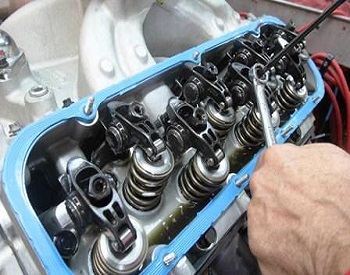
Some of the more common problems people experience with engine valves include noise and smoke issues.
Often when you hear a ticking noise from the engine a mechanic tells you that this represents a valve tap. Inadequate lubrication remains a strong possibility if the upper end of the engine becomes noisy.
Lubrication issues stemming from low oil pressure, but also obstructed oil passages due to engine sludge or poor maintenance take center stage.
Now for the the main reason we don’t ignore a valve tap. A lack of lubrication issue causes rapid stem and valve guide wear. This could eventually lead to engine failure. This is why when an upper engine noise surfaces it usually doesn’t get better it gets worse. However, if you drive the car every day you might not notice it.
If the engine valve tap is addressed quickly low oil pressure problems can be solved. In some cases replacing a worn-out oil pump does the trick. What if the root cause of the tap points to lack of maintenance? Restoration of restricted oil passages, depending on the severity, could save the engine from the junkyard.
Cleaning the oil pick up screen with either engine flushes or better yet physically cleaning it by removing the pan helps the problem. Also you clear the oil lubrication galleries with mechanics wire and solvents. With full lubrication restored the engine gets reevaluated and maybe saved.
Worn Valve Seals and Blueish Smoke
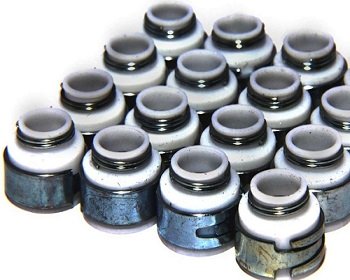
When it comes to engine smoking issues, it can be caused by engine valves, but also other parts like worn piston rings.
However, when you get a puff of blue smoke that’s seen on cold engine start up, most often you can pin the problem on excessive valve guide clearance or worn valve seals.When I say puff, I mean it only smokes a short period of time.
If the engine smokes all the time or on heavy acceleration the problem is more likely to be worn piston or oil control rings. This condition is confirmed with a wet and dry compression test.
However, in both cases, I recommend professional diagnosis. And if possible a second opinion before spending a lot of money on large engine repairs.
You can inspect engine valve seals for dry rot, wear and condition. You’ll also need to measure the guide clearance with a dial indicator and compare this precise measurement to manufacturer specifications.
Worn Out Valve Guides Repaired
If the clearance increases beyond specifications, oil drawn down both the intake and exhaust valve guides burns in the combustion chamber with the air/fuel charge causing a bluish colored smoke from the tailpipe.
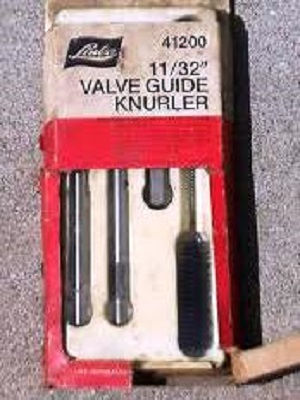
As far as the solutions for smoke problems, if they are pinpointed to valve train issues they can often be solved without engine replacement. In fact in the case of worn valve seals mechanics replace them using special tools without even removing the cylinder heads.
If it turns out that the smoke problem is related to excessive valve guide to stem clearance a we apply a short-term solution known as knurling the valve guides.
Knurling of valve guides is a process for restoring the proper clearance. We use a special tool that physically cuts into the guide and metal is raised up on either side of the tools cutting blade.
This actually decreases the inside diameter of the hole that the valve fits in. Then a finishing tool flattens the new ridges so the engine valves move smoothly in their bores.
Back in the old days many auto repair shops performed their own valve jobs and machine work. Today it is more common that the auto repair center will remove the cylinder heads and send them out to a specialized shop that performs the actual repairs.
In either case human error can reduce the longevity of the repairs. If you have a valve job performed it’s nice to know what kind of warranty the maintenance center and or machine shop will provide to cover workmanship. People with these skills often stand behind their work.
Intake Vs Exhaust Valve Problems
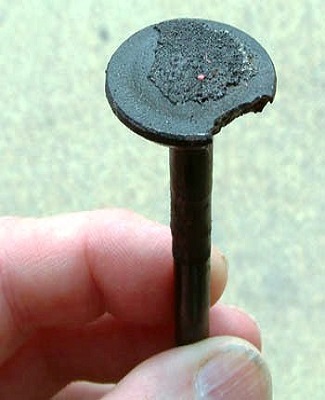
When an engine valve becomes damaged and no longer sealing off the combustion chamber we consider the valve burned. It gets this nick name, because when you take the engine apart you’ll often see heat damage.
When you have a burnt valve it will make a popping sound on the combustion stroke of that cylinder. You can tell if the burned valve lives on the intake side or exhaust side by where the popping noise comes from.
If it pops out of the exhaust system tail pipe its an exhaust valve issue. If you hear a pop sound better through the throttle body in the engine compartment, then the intake valve represents the cause. You can isolate the cylinder by performing a compression test. The cylinder with the problem will have much lower compression then the healthy cylinders.
Although I wouldn’t consider engine repairs a good project for the driveway mechanic learning more about the process can help you negotiate with the repair shop. I have about 10 more pages on the subject of understanding and testing automotive engines that might help.
Hows this for an interesting idea? Build your own scale plastic working car engine model and you’ll completely understand how a motor works by the time your finished.
If you would like to learn more about the you fix cars website this next link will take you to the homepage from this article about engine valves.

